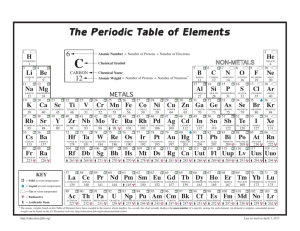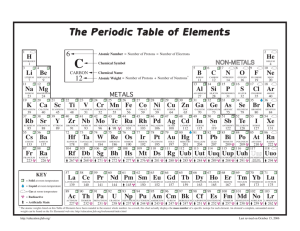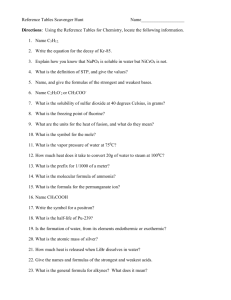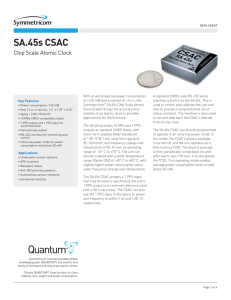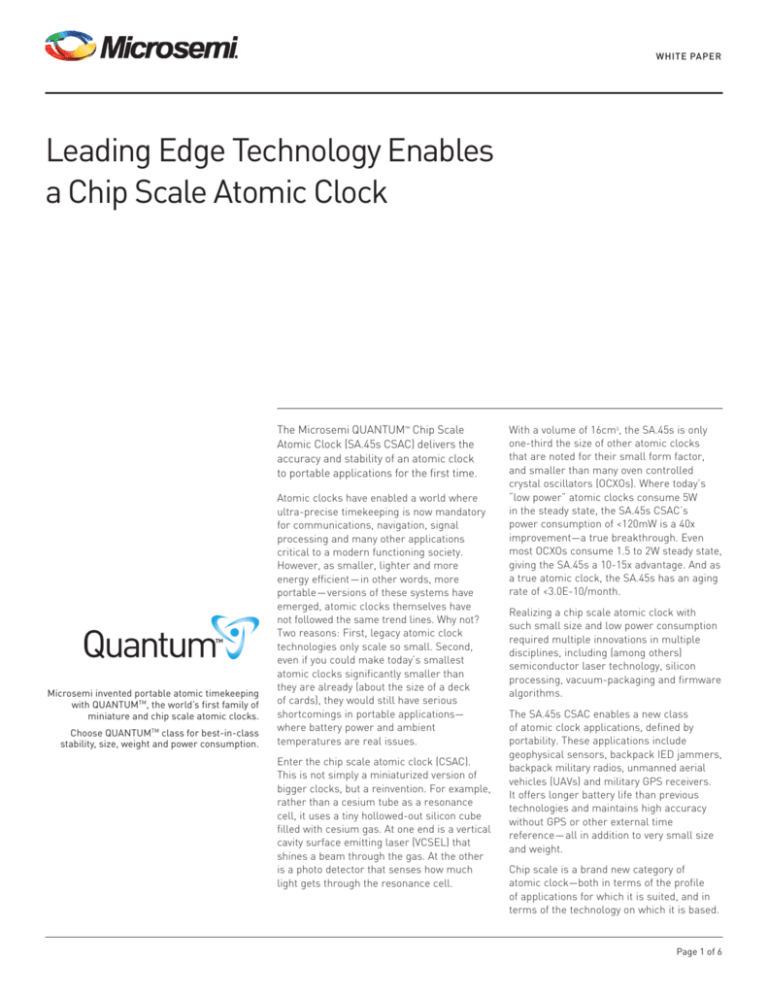
WHITE PAPER
Leading Edge Technology Enables
a Chip Scale Atomic Clock
The Microsemi QUANTUM™ Chip Scale
Atomic Clock (SA.45s CSAC) delivers the
accuracy and stability of an atomic clock
to portable applications for the first time.
Microsemi invented portable atomic timekeeping
with QUANTUMTM, the world’s first family of
miniature and chip scale atomic clocks.
Choose QUANTUMTM class for best-in-class
stability, size, weight and power consumption.
Atomic clocks have enabled a world where
ultra-precise timekeeping is now mandatory
for communications, navigation, signal
processing and many other applications
critical to a modern functioning society.
However, as smaller, lighter and more
energy efficient—in other words, more
portable—versions of these systems have
emerged, atomic clocks themselves have
not followed the same trend lines. Why not?
Two reasons: First, legacy atomic clock
technologies only scale so small. Second,
even if you could make today’s smallest
atomic clocks significantly smaller than
they are already (about the size of a deck
of cards), they would still have serious
shortcomings in portable applications—
where battery power and ambient
temperatures are real issues.
Enter the chip scale atomic clock (CSAC).
This is not simply a miniaturized version of
bigger clocks, but a reinvention. For example,
rather than a cesium tube as a resonance
cell, it uses a tiny hollowed-out silicon cube
filled with cesium gas. At one end is a vertical
cavity surface emitting laser (VCSEL) that
shines a beam through the gas. At the other
is a photo detector that senses how much
light gets through the resonance cell.
With a volume of 16cm3, the SA.45s is only
one-third the size of other atomic clocks
that are noted for their small form factor,
and smaller than many oven controlled
crystal oscillators (OCXOs). Where today’s
“low power” atomic clocks consume 5W
in the steady state, the SA.45s CSAC’s
power consumption of <120mW is a 40x
improvement—a true breakthrough. Even
most OCXOs consume 1.5 to 2W steady state,
giving the SA.45s a 10-15x advantage. And as
a true atomic clock, the SA.45s has an aging
rate of <3.0E-10/month.
Realizing a chip scale atomic clock with
such small size and low power consumption
required multiple innovations in multiple
disciplines, including (among others)
semiconductor laser technology, silicon
processing, vacuum-packaging and firmware
algorithms.
The SA.45s CSAC enables a new class
of atomic clock applications, defined by
portability. These applications include
geophysical sensors, backpack IED jammers,
backpack military radios, unmanned aerial
vehicles (UAVs) and military GPS receivers.
It offers longer battery life than previous
technologies and maintains high accuracy
without GPS or other external time
reference—all in addition to very small size
and weight.
Chip scale is a brand new category of
atomic clock—both in terms of the profile
of applications for which it is suited, and in
terms of the technology on which it is based.
Page 1 of 6
WHITE PAPER
Leading Edge Technology Enables a Chip Scale Atomic clock
The Atomic Clock Reinvented
The SA.45s CSAC employs coherent
population trapping (CPT) to interrogate
an atomic frequency. A laser illuminates
atoms in a reso­nance cell with polarized
radiation at two sidebands separated by the
atomic resonance frequency. The atoms
are excited to a non-scattering coherent
superposition state from which further
scattering is suppressed. The small size and
low power of the CSAC is enabled by a novel
electronic architecture, in which much of the
functionality of conventional atomic clocks
has been implemented in firmware rather
than hardware.
The SA.45s electronic hardware consists
of a low-power digital-signal processor, a
high-resolution microwave synthesizer, and
analog signal processing. The microwave
output is derived from a tunable crystal
oscillator and is applied to the laser within
the physics package to generate the two
sidebands necessary for CPT interrogation.
A photodetector detects light transmitted
from the laser after it passes through the
cesium vapor resonance cell. Based on
the measured response of the atoms, the
microprocessor adjusts the frequency of the
crystal oscillator.
The microwave synthesizer consists of a
4.6GHz voltage-controlled oscillator (VCO),
which is phase-locked to a 10MHz TCXO. This
synthesizer enables the SA.45s to provide a
standard RF frequency output at 10.0MHz
with the relative tuning between the TCXO
and VCO digitally controlled with a resolution
of better than 1 part in 1012. For interrogation
of the atomic resonance, modulation is
applied via the microwave synthesis chain,
thus avoiding the detrimental impact of
modulation appearing on the TCXO output.
The SA.45s CSAC performance is largely
determined by the characteristics of the
physics package. Short-term stability is
determined by the atomic resonance line
width (see sidebar) and the signal-to-noise
of the recovered signal. Medium-term
stability is determined by the temperature
stability of the physics package and by the
stability of auxiliary servos that stabilize the
laser power and wavelength, the microwave
power and the cell temperature. Long-term
stability is determined by the long-term
evolution of the properties of the laser and
the contents of the resonance cell.
..
..
..
..
..
..
.
Figure 1. SA.45s physics package. The cutaway drawing on the left shows the leadless chip carrier,
used to mount the physics package to the printed circuit board, in brown, and the ceramic cap which
maintains the vacuum around the physics package, in gray. The photo on the right shows the physics
package mounted to the printed circuit board and covered with a layer of mu-metal shielding.
The physics package (Figure 1) consists of a
“center stack” and a “thermal isolation system.”
Obtaining a Precise Resonance Line
The center stack consists of a specialpurpose VCSEL, the atomic vapor resonance
cell and the photodiode. The laser light,
emerging from the VCSEL, diverges as
it transits a cell spacer before passing
through the resonance cell and is detected
on the photo detector. The center stack
must be temperature-stabilized at a specific
temperature, between 85°C and 95°C, which
is precisely determined by the characteristics
of the individual VCSEL device.
In CPT, the precision of the atomic
resonance line is critical to determining
clock stability—i.e., a wide and blurry line
is more difficult to lock to than one that
is narrow and high-contrast.
The function of the thermal isolation system
is to support the center stack mechanically
while providing a high degree of thermal
isolation to the ambient environment,
thereby minimizing the required heater
power. The thermal isolation system consists
of the upper and lower suspensions and
the vacuum package. Vacuum packaging
eliminates thermal loss due to gas
conduction and convection. Thermal loss
due to conduction is minimized through the
design of the suspensions. The upper and
lower suspensions are manufactured from
a thin layer of polyimide film onto which are
patterned the metal conductors, which carry
signals to and from the center stack.
Two principal optical transitions are
available for CPT interrogation of the
cesium ground state resonance. These
two are termed “D1” and “D2,” with
principal optical transitions at λ=894 nm
and λ=852 nm, respectively. Because the
D1 transition has lower degeneracy in the
excited optical state, it exhibits a narrower
line width and higher contrast than D2[1,2].
The overall dimensions of the suspensions
are chosen so that the center stack is
suspended between two “drum heads” of
polyimide. This architecture is quite sturdy,
capable of surviving mechanical shock in
excess of 1000g (1ms half-sine), and
provides extraordinarily high thermal
resistance (>5000°C/W). Moreover, by
Two key factors help determine resonance
line quality: 1) the choice of the optical
transition for CPT interrogation; and 2)
the VCSEL’s cavity geometry.
The VCSEL must operate in a single
transverse cavity mode; its polarization
must remain stable, and it must
produce a wavelength that tunes to the
atomic resonance across the CSAC’s
operating temperature range for the
life of the product [3]. Meeting these
requirements—i.e., to sustain a 894nm
wavelength resonance—calls for
modifying the semiconductor processing
steps commonly used to make the 850nm
oxide-aperture VCSELs prevalent in the
telecommunications industry.
Page 2 of 6
WHITE PAPER
Leading Edge Technology Enables a Chip Scale Atomic clock
patterning the electrical connections
onto the polyimide, they do not need to
be mechanically self-supporting, thus
allowing their dimensions to be determined by electrical, rather than mechanical,
requirements and thereby reducing heat
load due to thermal conduction through the
(metallic, high conductivity) connections.
Performance Benchmarks
As innovative as the CSAC’s design is, most
users will gauge its value by its performance
benchmarks. In summary, these include:
• 16cm3 volume
• 35g weight
• ±5.0E-11 accuracy at shipment
• σy <5 x 10-12 at τ = 1 hour short-term
stability (Allan Deviation)
• <3.0E-10/month aging rate
• <120mW power consumption
The CSAC’s specifications for initial
accuracy, short-term stability and aging are
all characteristic of atomic clocks—clearly
a breakthrough given the SA.45s’s size and
weight. And while size and weight have
obvious relevance to portability, frequency
aging (Figure 2) is of the highest importance
to applications that may be cut off from GPS
timing signals for long periods.
..
.. Figure 2. SA.45s Frequency Aging
Portable applications are usually battery
powered, which makes power consumption
another key issue. Not only is the CSAC’s
power consumption very low; it varies very
little over temperature (Figure 3) and hardly
at all during warm-up, which is very short
compared to other atomic clocks. These too
are benefits of the physics package design.
The SA.45s CSAC features a unique
“ultra-low power mode” for even lower
power consumption. In this operating mode
the physics package is turned off most of
the time and the TCXO is allowed drift for a
user-defined interval after which the physics
package is turned back on and the TCXO is
re-calibrated. As an example, suppose the
physics package runs once every 55 minutes
for five minutes to recalibrate the TCXO. The
SA.45s consumes <30mW, as follows:
..
.. Figure 3. Power Consumption Over Temperature
• <20mW in TCXO-only mode (55 minutes)
• <110mW during physics package warm-up
(≈ 2 minutes)
• <100mW during full operation interval
(≈ 3 minutes)
Page 3 of 6
WHITE PAPER
Leading Edge Technology Enables a Chip Scale Atomic clock
Figure 4 shows the frequency offset over
14 hours in this scenario.
CSAC’s Application Profile
In light of these performance benchmarks,
the “best fit” SA.45s applications would be
those where a TCXO or OCXO would:
• Consume too much power, or
• Not be accurate enough, or
• Have insufficient holdover performance, or
• Be too large, or
• Be any combination of the above
Prime candidates fitting the CSAC’s
application profile include:
• Undersea seismic sensing
• Dismounted (backpack) IED jammers
• Dismounted (backpack) military radios
• Enhanced military GPS receivers
• Tactical UAVs (unmanned aerial vehicles)
..
.. Figure 4. Power Consumption Over Temperature
Undersea Seismic Sensing
Several classes of underwater sensor systems
rely on precise timing to be effective. Precise
time from GPS is unavailable underwater,
and so such sensors have generally relied
on OCXOs for stable and accurate time
stamping within the sensor.
Oil and gas exploration firms place a grid of
geophysical sensors (Figure 5) on the ocean
floor to help determine likely spots where
petroleum deposits are located. Sensors can
be dropped over the side of a ship or laid
down by a remotely piloted vehicle. Each
sensor typically includes a hydrophone, a
geophone and an OCXO or a TCXO that is
used to time stamp the data received by
the two other devices. The sensors can be
independent or a cable can connect a row
of sensors. Once the sensors are in place,
a powerful air gun or array of air guns
launches a sonic pulse from a ship. The ship
moves in a pattern that allows the air gun to
be fired from many different angles relative
to the sensor grid.
Some of the pulse’s energy reflects off the
ocean floor and back to the surface, but
the rest penetrates the ocean floor, travels
through the layers of rock underneath and
even­tually reflects back to the sensors
where it is time stamped. Once the ship
has finished its predetermined pattern, the
sensors are retrieved along with the time
..
.. Figure 5. Reflection Seismology Application.
Page 4 of 6
WHITE PAPER
Leading Edge Technology Enables a Chip Scale Atomic clock
Microsemi’s SA.45s CSAC can greatly
improve the accuracy, reduce the cost and
reduce the effects of temperature on sensor
systems.
For even lower power consumption, the
SA.45s can also be programmed to operate in an ultralow-power mode. As described above, the SA.45s’s physics package is turned off, and the unit operates
as a free-running TCXO. In the ocean’s
isothermal environ­ment, the TCXO’s drift
will be minimal. The physics package is
then periodically (under program control)
turned back on and after warm-up (<120
sec) redisciplines the TCXO. This mode
enables average power consumption
levels well below 50mW.
•Improved accuracy from lower aging
• Less frequency shift with temperature
stamped data. Because the sonic pulse
travels at different speeds in different
materials, the “bounce back” times are
different based on which materials the pulse
traversed. When this timing data is postprocessed, it creates a picture of the layers
of rock and sediment beneath the ocean
floor, showing which locations likely hold oil
or gas deposits.
During a typical deployment, sensors
can be underwater for several weeks at a
time. This is because the ships and crews
needed to deploy the sensors, take the
measurements and retrieve the sensors
cannot always be optimally scheduled.
Bad weather can also cause delays.
Throughout the deployment, the OCXOs
in the sensors are aging, producing a
time stamping error that varies as the
square of the time underwater. The
SA.45s’s low aging rate—which can be
1/100th of even a good OCXO—greatly
reduces these time stamping errors.
• Lower costs from reduced power
consumption
Batteries are typically the biggest
expense in these underwater sensors—
and the number of sensors (hence, also
batteries) in a typical grid is constantly
increasing. Because the SA.45s consumes one-tenth to one-twentieth the
power of an OCXO, it requires much less
battery power, which means smaller and
lower-cost sensors. Alternatively, sensor manufacturers can choose to retain
the existing battery capacity and use
the SA.45s to create sensors with much
longer mission lives.
Today most marine geophysical sensors
are calibrated to GPS on the deck of the
boat before being dropped into the ocean.
Because the water at the bottom of the
ocean is often just a few degrees above
freezing, the sensor can see a temperature
change of 30°C or more from its calibration temperature, causing a shift in
frequency and a linear error in time. Some
sensors use software models to correct
for this error, but the best approach is to
minimize the error to begin with. With a
temperature coefficient of ±5.0x10-10 over
its entire temperature range, the SA.45s
can offer a 10x to 1000x improvement over
the OCXO or TCXO alternatives typically
used for this application.
Dismounted IED jammers
Today’s IED jammers have power
requirements that can only be met by a
vehicle’s generator. In addition to lower
power consumption, a dismounted jammer
would also require key components to
be smaller and lighter—i.e., exactly the
combination of benchmarks on which the
SA.45s surpasses an OCXO. Today’s jammers
also jam all signals, including friendly force
communications. This can be overcome if all
the jamming signals are tightly synchronized
to allow pre-defined time slots in the
signals (“look windows”) where friendly
force communications can get through.
The SA.45s’s high accuracy, even over wide
temperature swings, can enable this level of
synchronization, and maintain it, even during
a lengthy absence of GPS.
Dismounted military radios
As new, higher-bandwidth waveforms
(necessary for the explosion of data and
video communications that the services are
experiencing) are introduced, the amount
of drift that is tolerable will decrease. This
means that OCXOs and TCXOs may no longer
be suitable reference oscillators. However,
the SA.45s’s atomic clock performance will
meet these more demanding requirements.
Its small size and low power consumption
also make it very attractive for man-pack
applications. And it provides the stability
needed to maintain network synchronization
in GPS-denied environments.
Military handheld GPS units
Using the SA.45s as a time base, military
GPS receivers can achieve greatly reduced
Time To Subsequent Fix (TTSF) for 24 hours
or more. It also becomes possible to operate
with only three satellites in view (instead of
the usual four), a distinct advantage in many
urban settings.
Tactical UAVs (Unmanned Aerial Vehicles)
Unmanned aircraft (drones) are always
challenged in three areas where the SA.45s
excels—size, weight and power (SWaP). In
some applications the CSAC is attractive
solely because its low power consumption
simplifies thermal management issues, such
as when compared to conventional rubidium
oscillators (~20W in warm-up, ~10W in
steady state).
In addition, many UAVs rely on GPS, and the
SA.45s CSAC can be disciplined by the 1PPS
output from a GPS receiver, thus providing
a stable signal that can be used by C4I or
even SIGINT payloads. Furthermore, should
GPS be lost due to natural interference
or jamming, the CSAC provides a stable
holdover signal that meets the requirements
of even long-endurance missions.
Page 5 of 6
WHITE PAPER
Leading Edge Technology Enables a Chip Scale Atomic clock
The Next Era in Atomic Timekeeping
These examples offer a view into what the
chip scale era in timekeeping will look like.
The SA.45s CSAC delivers the accuracy
and stability of an atomic clock to portable
applications for the first time—within those
applications’ severe limits on power, size
and weight. It is comparable to other atomic
clocks and surpasses OCXOs and TCXOs by
wide margins in initial accuracy and aging.
Portable applications that had to settle for
TCXO performance due to power constraints
no longer must. Until the CSAC, the lowestpower atomic clock was Microsemi’s own
SA.3xm series, with a steady-state power
of 5W. The SA.45s uses 1/40th of that power.
OCXOs offer better performance than TCXOs
but are typically in the 1-2W range. That
limits their applications to those with large,
heavy and expensive batteries or where
mission life is relatively short. Even then,
they are a compromise when compared to
a true atomic clock like the CSAC.
Quantum™ SA.45s CSAC Options
Spec
Opt 001
Opt 002
Opt 003
Opt 004
Steady-State Power
Consumption
<120mW
<125mW
<120mW
<120mW
TempCo
±5 x 10-10
±1 x 10-9
±5 x 10-10
±5 x 10-10
ADEV (Tau = 1000 s)
5 x 10-12
7 x 10-12
5 x 10-12
5 x 10-12
Warm-up Time
<130 s
<180 s
<130 s
<130 s
Predicted MTBF
>100,000 hrs.
>50,000 hrs.
>100,000 hrs.
>100,000 hrs.
Operational Temp
-10 °C to +70 °C
-40 °C to +85 °C
-10 °C to +70 °C
-10 °C to +70 °C
Output Frequency
10MHz
10MHz
16.384MHz
10.24MHz
Then there are size and weight issues, which
are always critical in portable applications.
The SA.45s is much smaller than any atomic
clock (one-third the size of the SA.3xm
series, the next smallest), and is generally
smaller than the OCXOs that approach its
performance. The unit height is especially
critical in many applications, and the SA.45s
is only 0.45 inches high.
Finally, perhaps the most critical point—
availability. The CSAC is not a laboratory
prototype. It provides autonomous, reliable
operation in production quantities today.
That means that when it comes to the next
era in atomic timekeeping, the clock is
already running.
[1] M. Stahler, et. al., “Coherent population trapping resonances in thermal 85Rb vapor: D1 vs D2 line excitation,” Optics Letters, vol. 27,
August 15, 2002, pp. 1472-1474.
[2] R. Lutwak, et. al., “The Chip-Scale Atomic Clock – Recent Development Progress”, Proceedings of the 35th Annual Precise Time and
Time Interval (PTTI) Systems and Applications Meeting, December 2-4, 2003, San Diego, CA, pp. 467-478
[3] D.K. Serkland, et. al. “VCSELs for Atomic Sensors,” Proceedings of the SPIE. Vol. 6484, 2007.
Microsemi Corporate Headquarters
One Enterprise, Aliso Viejo CA 92656 USA
Within the USA: +1 (800) 713-4113
Outside the USA: +1 (949) 380-6100
Sales: +1 (949) 380-6136
Fax: +1 (949) 215-4996
E-mail: sales.support@microsemi.com
Microsemi Corporation (Nasdaq: MSCC) offers a comprehensive portfolio of semiconductor and system
solutions for communications, defense and security, aerospace, and industrial markets. Products include
high-performance and radiation-hardened analog mixed-signal integrated circuits, FPGAs, SoCs, and
ASICs; power management products; timing and synchronization devices and precise time solutions,
setting the world’s standard for time; voice processing devices; RF solutions; discrete components; security
technologies and scalable anti-tamper products; Power-over-Ethernet ICs and midspans; as well as custom
design capabilities and services. Microsemi is headquartered in Aliso Viejo, Calif. and has approximately
3,400 employees globally. Learn more at www.microsemi.com.
© 2014 Microsemi Corporation. All rights reserved. Microsemi and the Microsemi logo are trademarks
of Microsemi Corporation. All other trademarks and service marks are the property of their respective
owners.
WP/LeadingEdgeTechnology_CSAC/082014


